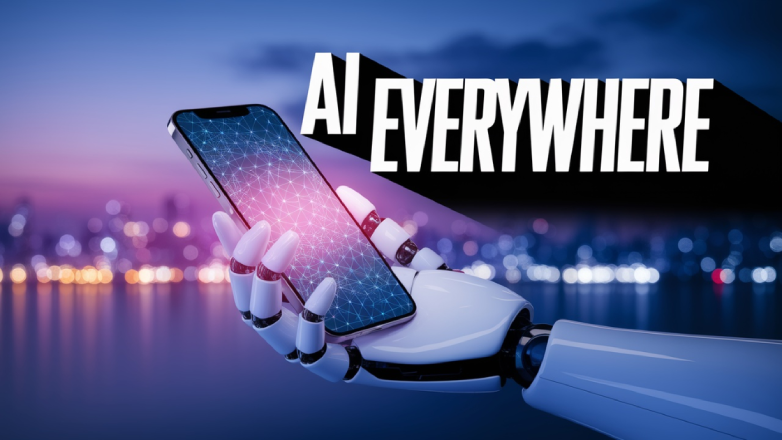Introduction
In the digital age, data is the new oil but it’s also becoming the new target. As Artificial Intelligence (AI) systems grow smarter and more pervasive, they are increasingly handling vast amounts of personal, financial, and medical data. While AI helps detect threats, optimize defenses, and automate security, it also creates new vulnerabilities and raises serious questions:
- How do we protect sensitive data in an AI-powered world?
- Can AI be trusted to guard, rather than expose, our privacy?
- What steps should businesses and individuals take to stay secure?
This article explores the intersection of AI and data security, the risks involved, and how we can build a more resilient and private digital future.
1. How AI Is Used in Cybersecurity
AI is a double-edged sword: it strengthens cybersecurity and introduces new risks. First, the good news AI is transforming how organizations defend against threats.
1.1 Threat Detection & Intrusion Prevention
AI-powered tools like Darktrace, CrowdStrike, and IBM Watson for Cybersecurity use machine learning algorithms to:
- Monitor network activity
- Detect anomalies and suspicious patterns
- Predict and prevent cyberattacks
These systems can analyze millions of logs per second far beyond the capacity of human analysts.
1.2 Behavioral Biometrics
AI tracks how users type, swipe, and move through digital environments. If it detects a deviation such as a login from an unusual device or an odd typing speed it can trigger security alerts or block access in real time.
2. The Risks: How AI Threatens Data Privacy
While AI strengthens security, it also increases data collection and exposure risks.
2.1 Massive Data Collection
AI needs large datasets to function. This often involves collecting:
- Browsing behavior
- Location history
- Voice commands
- Purchase records
- Health information
The more data collected, the greater the risk of leaks or misuse.
Example: In 2021, Facebook (now Meta) faced backlash when its AI models were revealed to have used personal photos, messages, and behavioral data to train ad-targeting systems—without explicit user consent.
2.2 Inference Attacks (Model Inversion)
AI models can sometimes infer private data even when it’s not directly collected. This is known as a model inversion attack—a method where hackers reverse-engineer AI systems to extract sensitive data.
Example: A Cornell University study showed that an AI model trained on medical data could be manipulated to reveal individual patient records, despite being anonymized.
2.3 Deepfakes and Synthetic Identity Fraud
AI-generated synthetic media can be used to:
- Bypass facial recognition
- Trick biometric systems
- Create fake identities to commit fraud
Example: In 2023, a Hong Kong-based finance company was defrauded of $25 million using AI-generated video deepfakes of their CEO during a fake Zoom call.
3. Protecting Data in the Age of AI: Key Strategies
3.1 Privacy by Design
AI systems should be built with data minimization and transparency in mind:
- Collect only what’s necessary
- Anonymize and encrypt data during processing
- Be transparent about how data is used
Tip: Tools like differential privacy allow AI to learn from patterns in data without exposing individuals.
3.2 Federated Learning
Federated learning is a privacy-preserving technique where AI models are trained across multiple devices without centralizing the raw data.
Example: Google uses federated learning in Android to improve predictive typing and voice recognition without pulling personal data into the cloud.
3.3 AI for Access Control & Threat Monitoring
AI can help organizations track who accesses sensitive data, when, and how. Suspicious behavior can trigger automated alerts, quarantines, or immediate shutdowns.
3.4 Encryption and Secure AI Models
Data should be encrypted:
- At rest (when stored)
- In transit (while being transferred)
- In use (while being processed by AI)
Emerging tech: Homomorphic encryption allows computations to be performed on encrypted data without decrypting it—adding another powerful layer of privacy.
4. Bias and Ethical Concerns in AI Security
AI isn't neutral. If trained on biased data, AI systems can replicate or amplify discrimination.
- Example: An AI-based security tool might disproportionately flag certain demographics for suspicious behavior if its training data was skewed.
- Solution: Diverse datasets, transparent algorithms, and fairness audits are critical for ethical AI deployment.
5. Regulatory Landscape: Governments Catching Up
5.1 GDPR (General Data Protection Regulation - EU)
Under GDPR:
- Users must be informed how their data is used
- Companies must report breaches within 72 hours
- Users can request deletion of their data ("right to be forgotten")
- Heavy fines for non-compliance (up to €20 million)
5.2 U.S. AI Bill of Rights (2022)
A proposed framework advocating for:
- Transparency in automated systems
- Protection against algorithmic discrimination
- Control over personal data and informed consent
These policies signal a growing recognition of the need for accountability in AI systems.
6. The Future: AI Securing AI
As threats grow more sophisticated, AI will increasingly be used to defend against itself. Future trends include:
- Self-healing systems that patch vulnerabilities in real-time
- AI-powered firewalls that adapt dynamically to new threats
- Zero-trust architectures with AI-driven identity verification
These advancements could make security systems more autonomous and resilient.
Conclusion
AI is transforming cybersecurity and data privacy—but it cuts both ways. While it enables more powerful defenses, it also introduces new vulnerabilities, biases, and ethical dilemmas.
To build a secure and equitable digital future, we must:
- Design AI with privacy, fairness, and transparency at the core
- Embrace regulation, oversight, and accountability
- Educate users, developers, and businesses on risks and protections
In the age of intelligent machines, protecting personal data isn’t just a technical challenge—it’s a human right that demands our attention, innovation, and integrity.







